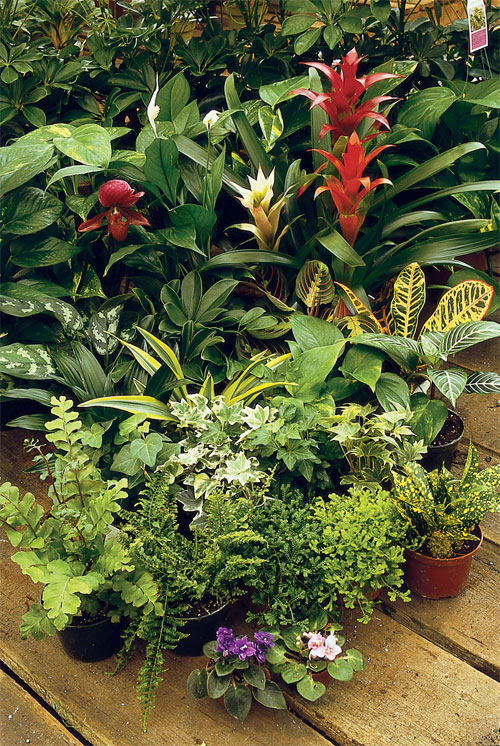Create a versatile, beautiful, tropical reptile vivarium.
There are many small, tropical or sub-tropical reptiles and amphibians that are attractive, inexpensive, regularly available and fairly easy to care for. These are mainly various kinds of little frogs, toads and lizards. There are also some salamanders and a few small snakes. Many of these come from the southeastern United States, and others come from similar habitats in other parts of the world. You can keep a nice assortment of these little creatures in a natural, tropical vivarium. Such a vivarium is basically a living work of art and looks good in any room of the house.

Rex Lee Searcey
There are many common, inexpensive, attractive tropical houseplants that can be used in a vivarium. Among those shown here are slipper orchid (Paphiopedilum sp.), dwarf peace lily (Spathiphyllum 'Starlight'), bromeliads (Guzmania), prayer plant (Maranta tricolor), pothos (Epipremnum pinnatum 'Aureum'), English ivy (Hedera helix), mahogany fern (Didymochlaena truncatula 'Lunulata'), club moss (Selaginella krausiana), gold dust croton (Codiaeum 'Gold Dust') and miniature African violets (Saintpaulia
Enclosure: This vivarium is actually quite simple to make. Start with a basic reptile tank with a sliding screen top. A small community of six to 10 small reptiles and amphibians can be housed in a 10- to 18-gallon tank. Tanks come in various sizes and styles in this range.
The one you choose will depend on the space you have for the vivarium and what animals you plan to keep in it. Get a shallow tank (i.e., 20 inches long by 10 inches wide by 10 inches tall) if you plan to keep mainly terrestrial animals, such as toads, salamanders, and certain frogs and lizards. Get a taller tank (i.e., 20 inches long by 10 inches wide by 18 inches tall) if you want to add a small tree or tall piece of wood for some arboreal animals, such as tree frogs, anoles, day geckos and rough greensnakes.
Lighting: You need a good light to keep the animals and plants healthy. This is very important. Regular fluorescent lights and regular light bulbs won’t work. You need to use compact fluorescent lights. They cost a little more than the regular fluorescent lights, but are well worth it and absolutely necessary. You want to get full-spectrum daylight compact fluorescents.
For a vivarium in this size range, you want a fixture that has approximately 48 watts of light. This means the fixture has two U-shaped tube lights of approximately 24 watts each. Get a heavy-duty (grounded) timer and use it to set your lights to go on and off automatically. Set them to come on for about 12 to 13 hours per day, starting about an hour after sunrise.
Substrate: Spread a 1- to 2-inch layer of pea-sized gravel on the bottom of the tank for drainage. On top of this, place a 4-inch layer of a good forest vivarium planting mix (a simplified recipe for this would be one part ground coconut husk fiber and one part small or medium orchid bark or Xerimulch). Add an all-natural, organic, balanced fertilizer. Use about half the amount recommended on the label. For example, if the label recommends a quarter cup per gallon of soil, add only about an eighth of a cup per gallon of planting mix. Mix all ingredients thoroughly, moisten slightly and add to the vivarium.
Plants: Place fixtures, such as rocks, caves, water dishes, wood, etc. where you want them. Then add your plants. There are many nice tropical houseplants that you can use.
Before adding the plants, carefully but thoroughly wash off the leaves with room temperature water to remove any possible pesticides. Carefully tap the plants out of their pots, and remove most of the potting soil (be careful not to break off too many of the roots). Then plant them in the vivarium planting mix. You can then add various types of ground covers, like moss. When landscaping your vivarium, use your artistic skills and try to make it look as natural as possible.
Maintenance: Watering will rarely be necessary if you mist your vivarium daily using a spray bottle filled with distilled water. Try to maintain a humid environment. The planting mix should be moist but not wet.
Animals: Many different kinds of small reptiles and amphibians can be kept in a vivarium like this. Just a few examples include: green tree frogs (Hyla cinerea) and other similar small, native hylid tree frogs; some tropical tree frogs like red-eyes (Agalychnis callidryas); dart frogs (Dendrobates and others); firebelly toads (Bombina orientalis); oak toads (Bufo quercicus) and other small toads; slimy salamanders (Plethodon glutinosus) and other small salamanders; green anoles (Anolis carolinensis); long-tailed grass lizards (Takydromas sexlineatus); day geckos (Phelsuma) and other small geckos; rough greensnakes (Opheodrys aestivus), etc. Knowledgeable reptile or pet store personnel may be able to recommend some other possibilities.
The three different types of herp habitats described in this article should provide healthy, happy homes for the recommended animals. They are not difficult to maintain, and by starting with these, you just might be inspired to get even more creative with future herp-habitat projects. Your animals will thank you for it!


